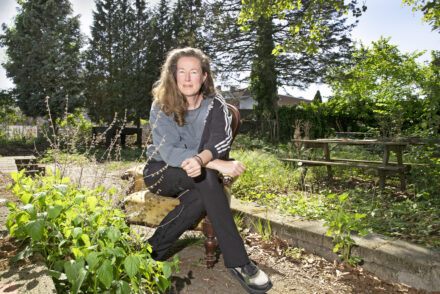The New Year’s murder: JADS students cooperate in police investigation
Students from the Jheronimus Academy of Data Science (JADS) are working on cold case ‘The New Year’s Murder’ and made a remarkable discovery. Univers spoke about it with Peter de Kock, Professor of Practice in Data Science at Tilburg University and initiator of citizen collective Bureau Dupin: “The police now call in the help of JADS students more often.”

Studying and participating in a murder investigation? A number of students from the Jheronimus Academy of Data Science (JADS) are spending their time as students in this unusual way. They are working with the East Brabant Police Unit on ongoing police investigations. The reason for this collaboration is the cold-case investigation The New Year’s Murder. In this investigation, JADS students analyzed telecom data and made a remarkable discovery. More about that later, first briefly the story of Marja Nijholt, the victim of The New Year’s Murder.
A reconstruction of The New Year’s Murder
On January 1, 2013, the lifeless body of Marja Nijholt from Enschede is found in Oss. In the days before her death, Nijholt was very concerned for her safety. For example, she writes to her acquaintances “to have become a refugee” and that she “can no longer stay in Europe.”
A few days before the turn of the year, Nijholt leaves for a hotel in Gronau, a town just across the German border near Enschede. She stays there for two nights and makes an anxious impression on the hotel owner. On the morning of New Year’s Eve, the hotel receives a call from an unknown Dutch man, who asks the hotel owner if Nijholt is at the hotel. After the hotel owner informs her of this telephone call, Nijholt leaves the hotel in a panic. She takes the train back to Enschede but does not go home. Instead, she travels to Oss, where she meets her end on the morning of New Year’s Day.
Why did the woman from Enschede go to Oss on New Year’s Eve? Was she murdered? Or did she kill herself? At the time the police are investigating the case, all leads are dead ends, and the above questions remain unanswered. They are unable to determine the cause of Nijholt’s death—soon known as the New Year’s Day murder. The prosecution decides to put the case on the shelf.
JADS students analyze telephone traffic
In 2020, the citizen collective Bureau Dupin takes the case off the shelf again. In this collective, a group of creative researchers (including techies, cab drivers, teachers, researchers, students, and artists) take the time to revisit all the clues in the case. “This in the hope of coming to new insights,” says Peter de Kock, Professor of Practice at Tilburg University, and an expert in data science in the field of crime and security.
‘We are not limited to highly trained experts; any citizen can participate’
“The police solve crimes according to certain methods. In most cases, this is effective. But in the occasional case—such as cold cases—it is not. The idea of Bureau Dupin is to apply a new methodology in the working of such cases. For example, we are not limited to highly trained experts, we are fully inclusive. Every citizen can participate, is equally important, and is an expert in his or her own field.”
The members of the research collective are assisted in their investigations by the police, judiciary, and the Public Prosecutor’s Office. This is unique, as never before have these agencies worked together with a group of investigative citizens. Last year, for example, the police released photos (on Bureau Dupin’s online forum) of the crime scene showing both Marja Nijholt’s body and her belongings.
The police also shared telecom data (code numbers), which they already secured nine years ago during the investigation into Nijholt’s death. This is a dataset containing information from thousands of phones that were in contact in the months before and after Nijholt’s death. Included in that set are Nijholt’s phone contacts. Because the data—for privacy reasons—have been pseudonymized, the members of Bureau Dupin cannot trace this data directly to telephone numbers and names.

However, you can analyze such a dataset and find out information about telecom patterns and locations. Data science students at the Jheronimus Academy of Data Science in Den Bosch ventured this task. Assisted by Professor of Practice Peter de Kock and telecom specialist René Pluijmers, they then made a remarkable discovery.
Data analysis leads to new questions
The JADS Students found out that Marja Nijholt most likely had not one but two phones in use. This is remarkable because this was not previously revealed in the research. In addition, the code number 9104 stands out among the students. According to them, this code number refers to the hotel in Gronau where Nijholt stayed. On the morning of December 31, 2012, a Dutch man calls this hotel and asks about her presence. When the hotel owner tells Marja about this phone call, she leaves the hotel in a panic. She takes the train back to Enschede to then travel on to Oss. The place where she finds her death.
If this suggestion is correct, and the code number 9104 does indeed refer to the hotel in Gronau, the same dataset shows that this hotel received three calls in the final days of 2012. One of these phone calls is uninteresting to the police because it was made before Nijholt checked into the hotel. Therefore, this phone call cannot have anything to do with her sudden departure for Oss. The third phone call is (like the first call) outside the timeline of the investigation. Namely, it was committed after Nijholt left the hotel and, therefore, uninteresting to the police.
JADS students’ analysis raises questions that police did not ask before
This leaves only one phone call within the timeline. Most likely, this call was made from Nijholt’s phone. Indeed, her code number matches—the students suspect—this phone call. Curiously, this means that the hotel was called only once in the days Nijholt stayed there. In fact, by her own phone number.
As a result of this analysis by the JADS students, questions arise in the investigation that the police have not asked before: where was Nijholt’s phone on December 30 at 6 p.m.? Was she calling the hotel herself or was someone else using her phone? And was it this particular call that scared her so much? These are questions that remain unanswered to this day.
Data tool and the wisdom of the crowd
Meanwhile, the JADS students have developed a number of software programs that allow other members of the Bureau Dupin community to analyze data independently. Members of the community can follow a “master class” (or watch again) on the online forum in which telecom expert René Pluijmers explains to them how to use these software programs: “These software programs make data insightful in a way that the police did not think possible in 2013. Bureau Dupin thus brings together modern data science with the substantive knowledge of other members. In this way, we hope—thanks to the wisdom of the crowd—to force a breakthrough in the investigation,” explains De Kock.
Cooperation between JADS and Police Unit East Brabant
That the involvement of JADS students in police investigations tastes like more is evidenced by the new master agreement between the JADS and the East Brabant Police Unit. “The police now call in the help of JADS students more often. For them, it is, without a doubt, valuable to cooperate with JADS students. Data science is a relatively young profession. Therefore, having the best and newest techniques in this field is important. Students have a lot of knowledge and expertise and are directly involved in research,” explains De Kock.
Moreover, De Kock believes that ongoing cooperation between universities, police, and the Public Prosecutor’s Office is valuable: “It promotes the quality of an investigation when the police make use of brand-new techniques and ways of thinking and inquisitive students. In addition, it makes students enthusiastic about the police profession.”
Incidentally, De Kock hopes for wider involvement of students from other disciplines in the future: “I welcome the participation of students from other fields of study at Tilburg University in this collective. For example, law students can help with legal issues. For example, they can research the GDPR (General Data Protection Regulation ed.) or highlight the legal side of this new cooperation. The same goes for students with a more anthropological study background. Knowledge about behavioral and social sciences are immensely valuable in this research.”
Bureau Dupin’s research is ongoing. Do you want to know more about the investigation? Then listen to the podcast series “ De Nieuwjaarsmoord” and “Op het Bureau” in your favorite podcast app. In the fall of 2022, Videoland will air a four-part documentary series about this investigation. Want to contribute thoughts or have tips? Then visit www.bureaudupin.org (in Dutch).
Translated by Language Center, Riet Bettonviel






